Anahita: Lady of Persia // published in Immanence Fall 2018
Click on the right-side of the images to read in the Magazine or scroll down for text only.
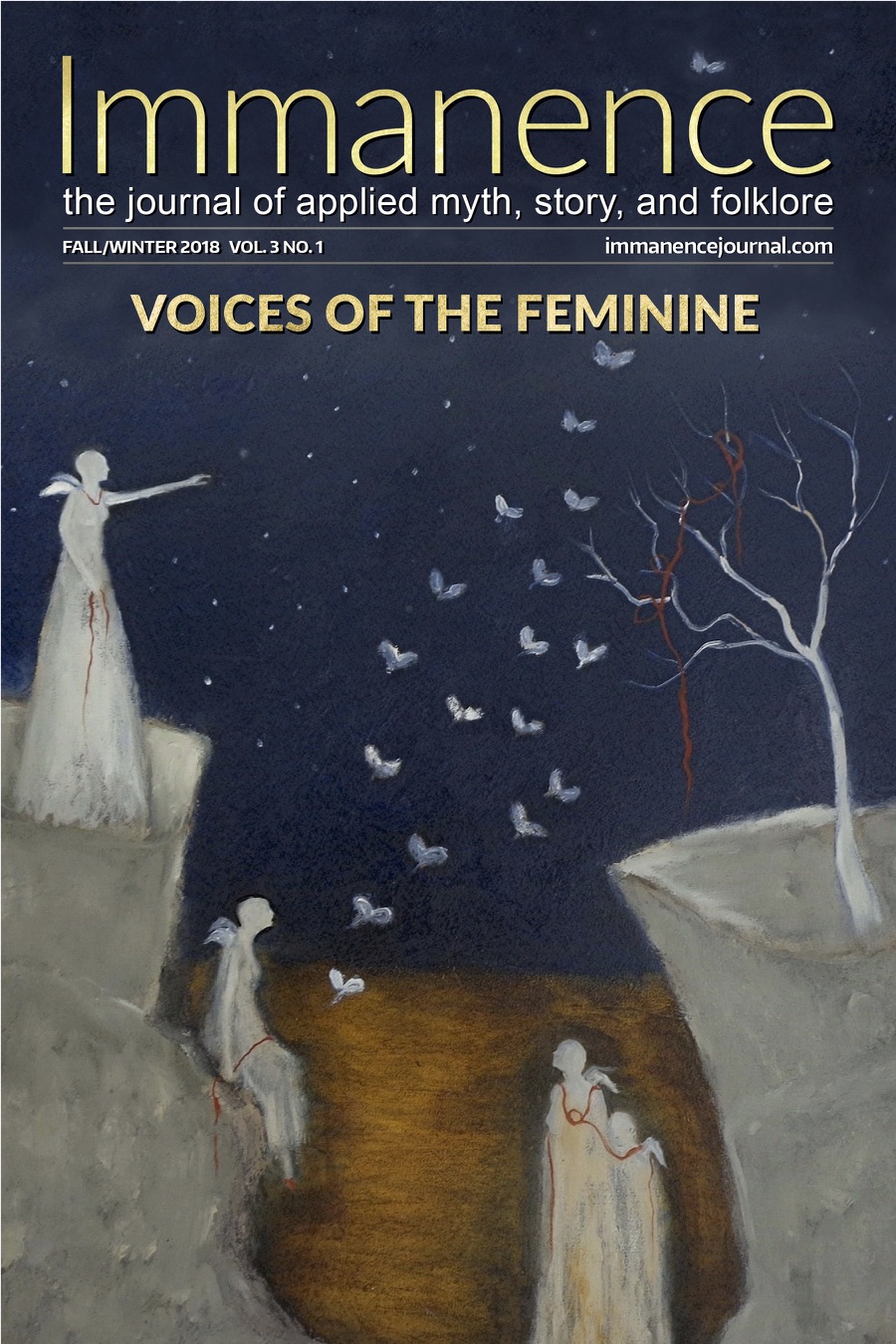
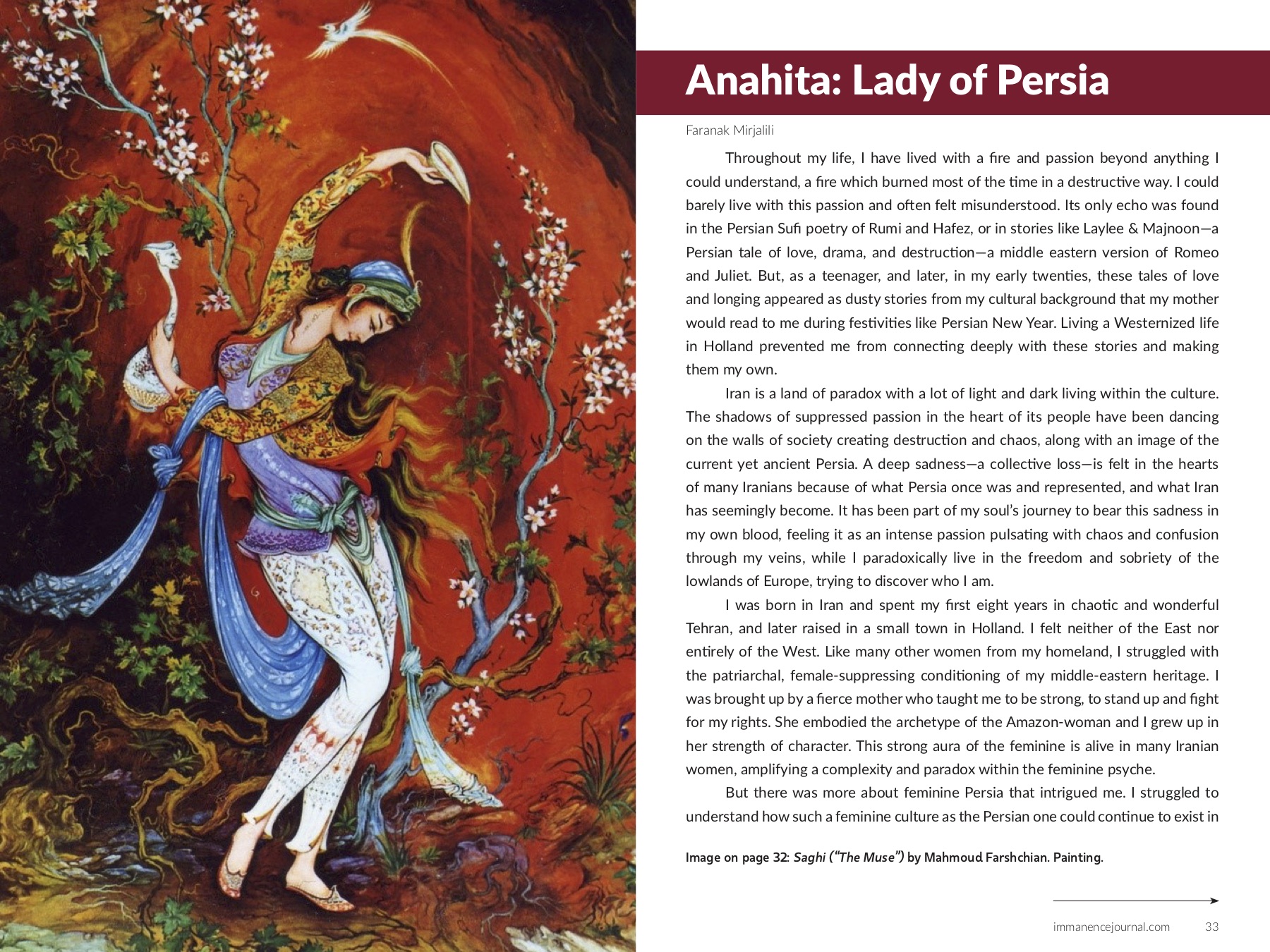
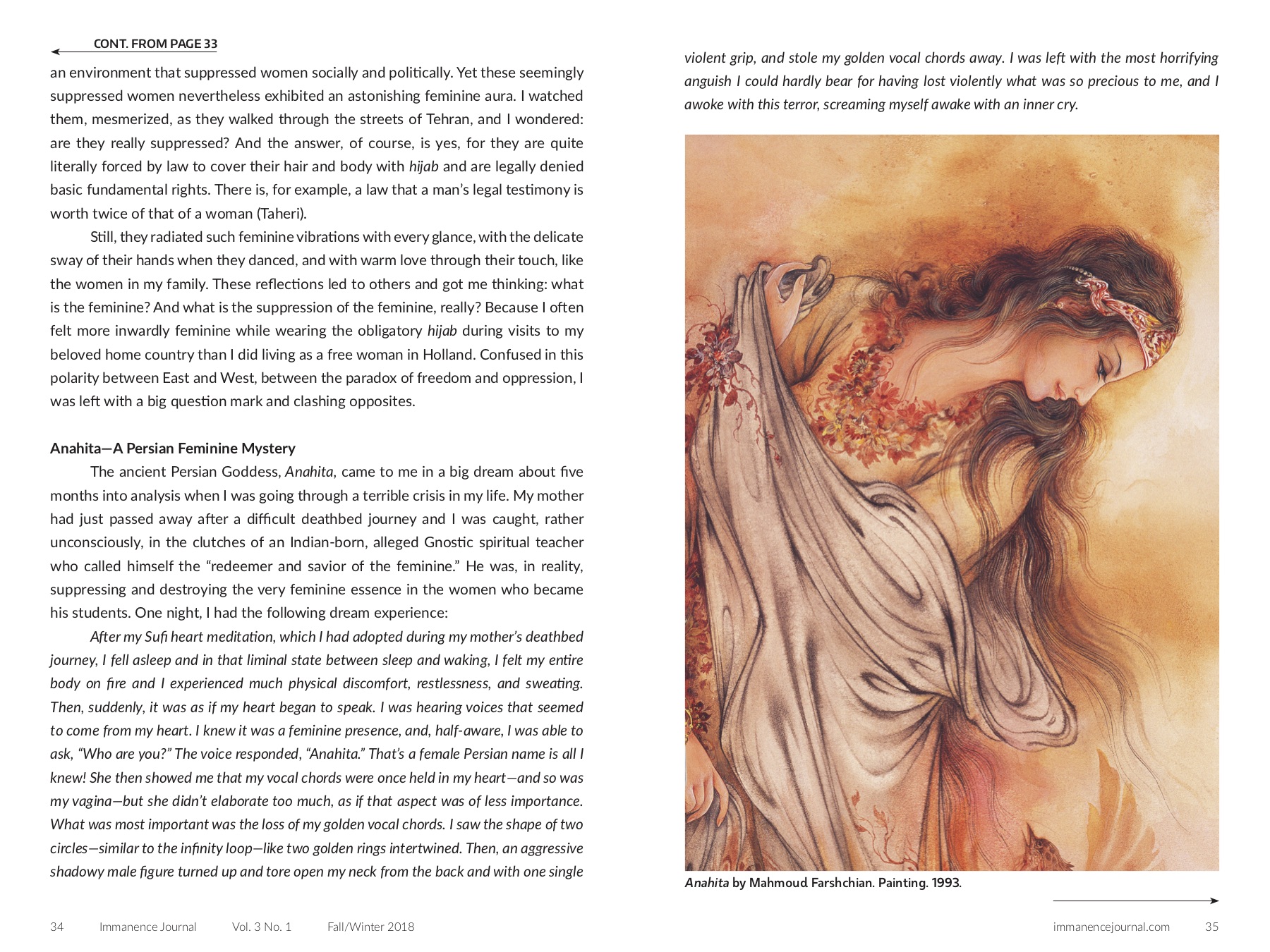
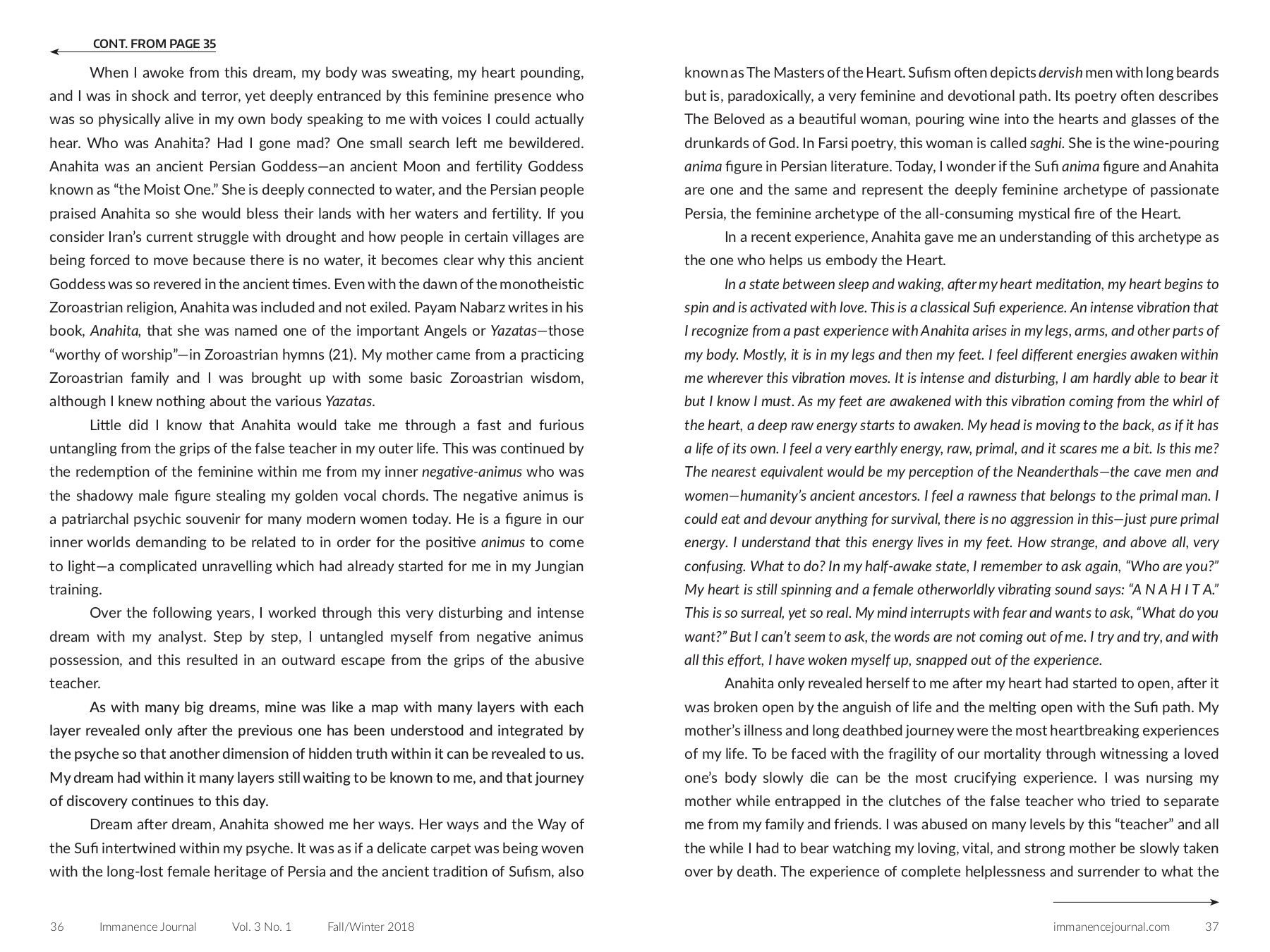
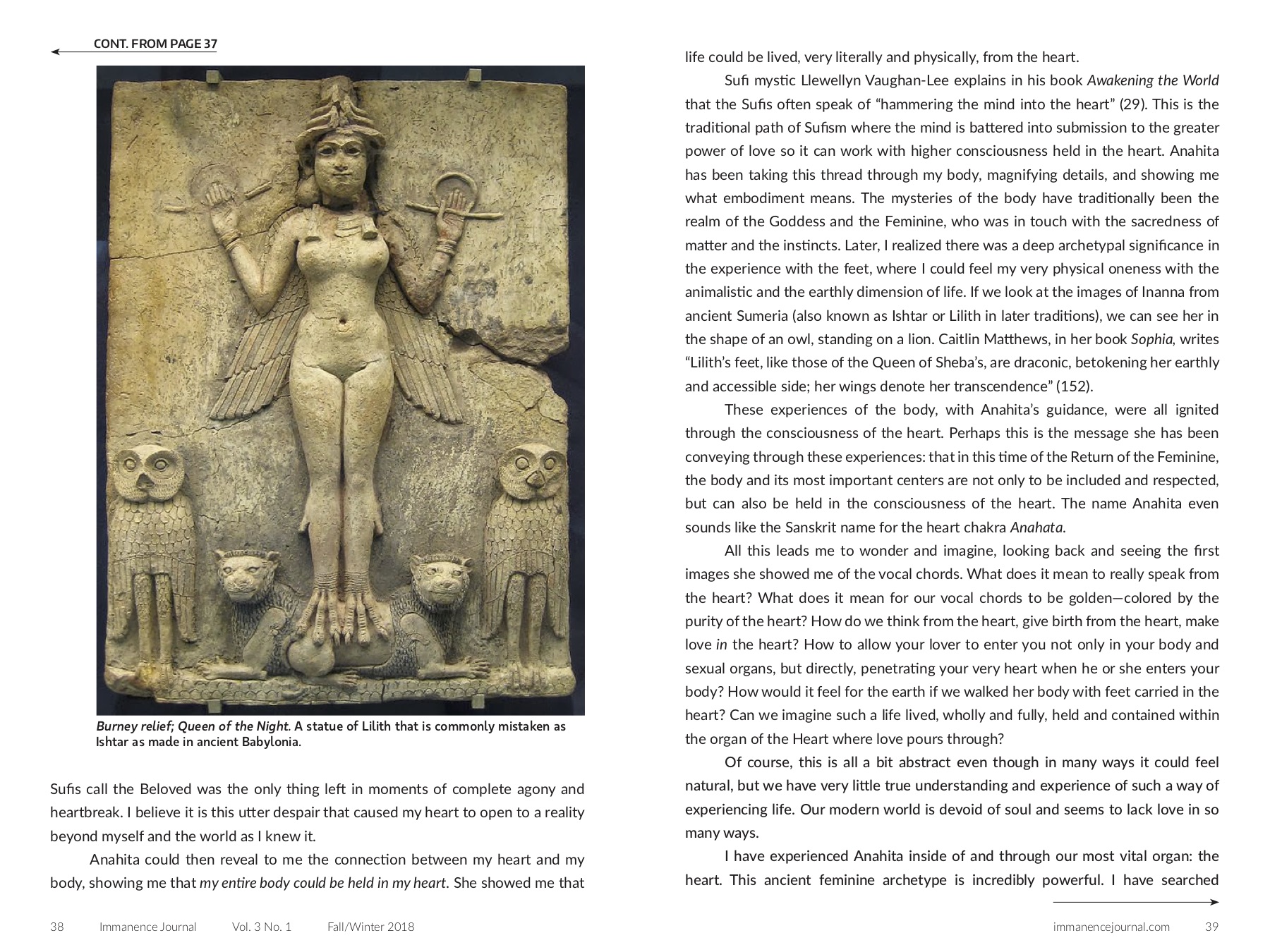
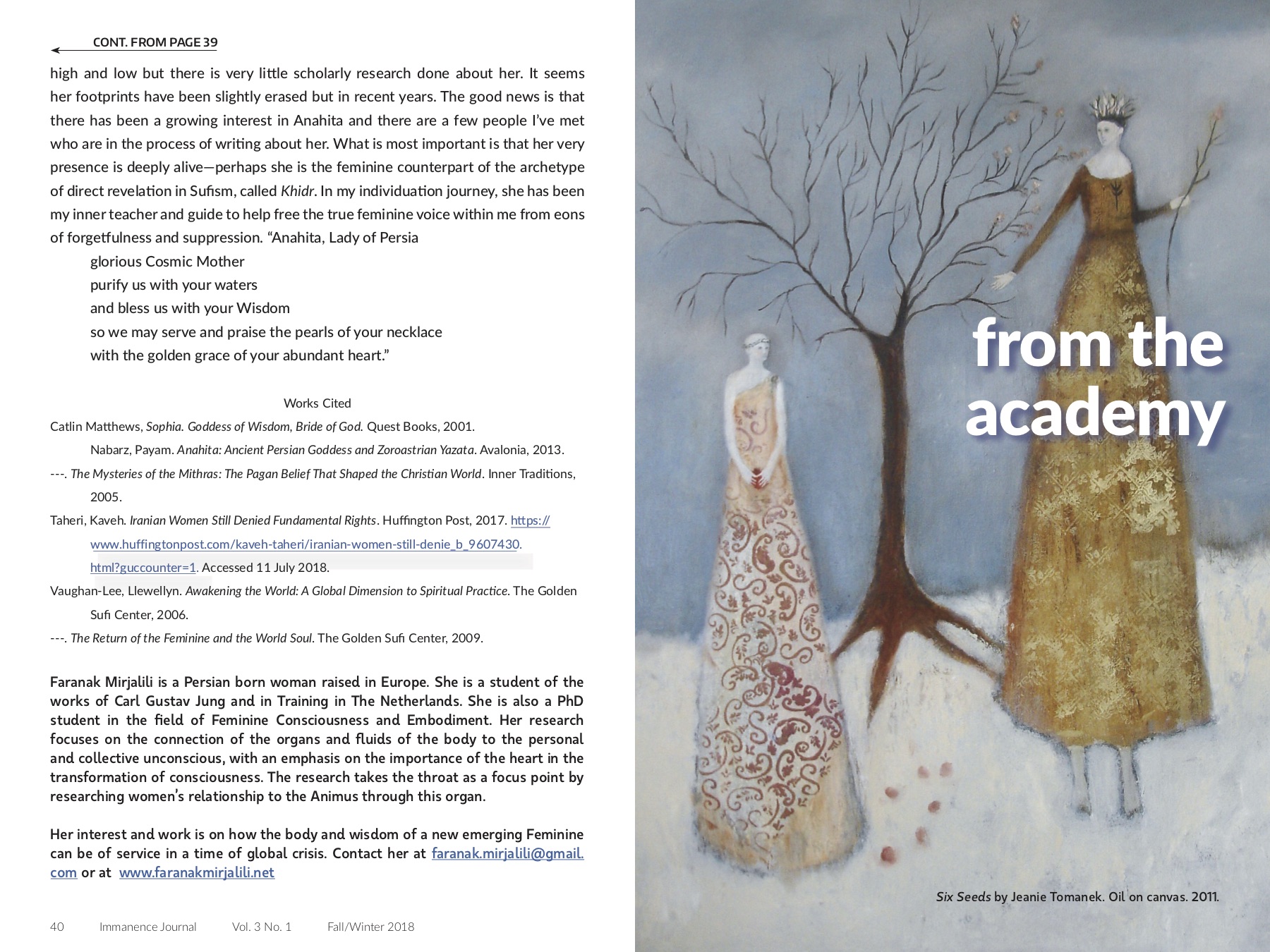
ANAHITa:
Lady of Persia
Throughout my life, I have lived with a fire and passion beyond anything I could understand, a fire which burned most of the time in a destructive way. I could barely live with this passion and often felt misunderstood. Its only echo was found in the Persian Sufi poetry of Rumi and Hafez, or in stories like Laylee & Majnoon—a Persian tale of love, drama, and destruction—a middle eastern version of Romeo and Juliet. But, as a teenager, and later, in my early twenties, these tales of love and longing appeared as dusty stories from my cultural background that my mother would read to me during festivities like Persian New Year. Living a Westernized life in Holland prevented me from connecting deeply with these stories and making them my own.
Iran is a land of paradox with a lot of light and dark living within the culture. The shadows of suppressed passion in the heart of its people have been dancing on the walls of society creating destruction and chaos, along with an image of the current yet ancient Persia. A deep sadness—a collective loss—is felt in the hearts of many Iranians because of what this part of the world once was and represented, and what Iran has seemingly become. It has been part of my soul’s journey to bear this sadness in my own blood, feeling it as an intense passion pulsating with chaos and confusion through my veins, while I paradoxically live in the freedom and sobriety of the lowlands of Europe, trying to discover who I am.
I was born in Iran and spent my first eight years in chaotic and buzzing Tehran, and later raised in a small town in Holland. I felt neither of the East nor entirely of the West. Like many other women from my homeland, I struggled with the patriarchal, oppressive patterning and cellular memory of a misogynist dictatorship. I was brought up by a fierce mother who taught me to be strong, to stand up and fight for my rights. She embodied the archetype of the Amazon-woman and I grew up in her strength of character. This type of woman are referred to as ‘Shirzan’ in Iran, which literally translates as She-Lion. This strong aura of the feminine is alive in many Iranian women, amplifying a complexity and paradox within the feminine psyche.
But there was more about feminine Persia that intrigued me. I struggled to understand how such a feminine culture as the Persian one could continue to exist in an environment that oppressed women socially and politically. Yet these seemingly oppressed women nevertheless exhibited an astonishing feminine aura and power. I watched them, mesmerized, as they walked through the streets of Tehran, and I wondered: are they really oppressed? And the answer, of course, is yes, for they are quite literally forced by law to cover their hair and body with hijab and are legally denied basic fundamental rights. There is, for example, a law that a man’s legal testimony is worth twice of that of a woman (Taheri).
Still, they radiated such femininity with every glance, with the delicate sway of their hands when they danced, and with warm love through their touch, like the women in my family. These reflections led to others and got me thinking: what is the feminine? And what is the suppression of the feminine, really? Because I often felt more inwardly feminine while wearing the obligatory hijab during visits to my beloved home country than I did living as a free woman in Holland. Confused in this polarity between East and West, between the paradox of freedom and oppression, I was left with a big question mark and clashing opposites.
Anahita—A Persian Feminine Mystery
The ancient Persian Goddess, Anahita, came to me in a big dream about five months into analysis when I was going through a terrible crisis in my life. My mother had just passed away after a difficult deathbed journey and I was caught, rather unconsciously, in the clutches of an Indian-born, alleged spiritual teacher who called himself the “redeemer and saviour of the feminine.” He was, in reality, suppressing and destroying the very feminine essence in the women who became his students. One night, I had the following dream experience:
After my Sufi heart meditation, which I had adopted during my mother’s deathbed journey, I fell asleep and in that liminal state between sleep and waking, I felt my entire body on fire and I experienced much physical discomfort, restlessness, and sweating. Then, suddenly, it was as if my heart began to speak. I was hearing voices that seemed to come from my heart. I knew it was a feminine presence, and, half-aware, I was able to ask, “Who are you?” The voice responded, “Anahita.” That’s a female Persian name is all I knew! She then showed me that my vocal cords were once held in my heart—and so was my vagina—but she didn’t elaborate too much, as if that aspect was of less importance. What was most important was the loss of my golden vocal cords. I saw the shape of two circles—similar to the infinity loop—like two golden rings intertwined. Then, an aggressive shadowy male figure turned up and tore open my neck from the back and with one single violent grip, and stole my golden vocal cords away. I was left with the most horrifying anguish I could hardly bear for having lost violently what was so precious to me, and I awoke with this terror, screaming myself awake with an inner cry.
When I awoke from this dream, my body was sweating, my heart pounding, and I was in shock and terror, yet deeply entranced by this feminine presence who was so physically alive in my own body speaking to me with voices I could actually hear. Who was Anahita? Had I gone mad? One small search left me bewildered. Anahita was an ancient Persian Goddess—an ancient Moon and fertility Goddess known as “the Moist One.” She is deeply connected to water, and the Persian people praised Anahita so she would bless their lands with her waters and fertility. If you consider Iran’s current struggle with drought and how people in certain villages are being forced to move because there is no water, it becomes clear why this ancient Goddess was so revered in the ancient times. Even with the dawn of the monotheistic Zoroastrian religion, Anahita was included and not exiled. Payam Nabarz writes in his book, Anahita, that she was named one of the important Angels or Yazatas—those “worthy of worship”—in Zoroastrian hymns (21). My mother came from a practicing Zoroastrian family and I was brought up with some basic Zoroastrian wisdom, although I knew nothing about the various Yazatas.
Little did I know that Anahita would take me through a fast and furious untangling from the grips of the false teacher in my outer life. This was continued by the redemption of the feminine within me from my inner negative-animus (the internalised dictator) who was the shadowy male figure stealing my golden vocal cords. The negative animus is a patriarchal psychic souvenir for many modern women today. He is a figure in our inner worlds demanding to be related to in order for the positive animus to come to light—a complicated unravelling which had already started for me in my first Jungian training.
Over the following years, I worked through this very disturbing and intense dream with my analyst. Step by step, I untangled myself from negative animus possession, and this resulted in an outward escape from the grips of the abusive teacher.
As with many big dreams, mine was like a map with many layers with each layer revealed only after the previous one has been understood and integrated by the psyche so that another dimension of hidden truth within it can be revealed to us. My dream had within it many layers still waiting to be known to me, and that journey of discovery continues to this day.
Dream after dream, Anahita showed me her ways. Her ways and the way of the Sufi intertwined within my psyche. It was as if a delicate carpet was being woven with the long-lost female heritage of Persia and the ancient tradition of Sufism, also known as The Masters of the Heart. Sufism often depicts dervish men with long beards but is, paradoxically, a very feminine and devotional path. Its poetry often describes The Beloved as a beautiful woman, pouring wine into the hearts and glasses of the drunkards of God. In Farsi poetry, this figure is called saghi. She or he is the wine-pouring anima figure in Persian literature. There are many questions unanswered about Anahita’s connection to this ancient mystical path and its symbols.
In more recent experiences, starting with this one below, Anahita introduced herself to me in her primal vibrational form, which Jung would refer to as the ‘psychoid’ form.
In a state between sleep and waking, after my heart meditation, my heart begins to spin and is activated with love. This is a classical Sufi experience. An intense vibration that I recognize from a past experience with Anahita arises in my legs, arms, and other parts of my body. Mostly, it is in my legs and then my feet. I feel different energies awaken within me wherever this vibration moves. It is intense and disturbing, I am hardly able to bear it but I know I must. As my feet are awakened with this vibration coming from the whirl of the heart, a deep raw energy starts to awaken. My head is moving to the back, as if it has a life of its own. I feel a very earthly energy, raw, primal, and it scares me a bit. Is this me? The nearest equivalent would be my perception of the Neanderthals—the cave men and women—humanity’s ancient ancestors. I feel a rawness that belongs to the primal man. I could eat and devour anything for survival, there is no aggression in this—just pure primal energy. I understand that this energy lives in my feet. How strange, and above all, very confusing. What to do? In my half-awake state, I remember to ask again, “Who are you?” My heart is still spinning and a female otherworldly vibrating sound says: “A N A H I T A.” This is so surreal, yet so real. My mind interrupts with fear and wants to ask, “What do you want?” But I can’t seem to ask, the words are not coming out of me. I try and try, and with all this effort, I have woken myself up, snapped out of the experience.
Anahita only revealed herself to me after my heart had started to open, after it was broken open by the anguish of life and the melting open with the Sufi path. My mother’s illness and long deathbed journey were the most heartbreaking experiences of my life. To be faced with the fragility of our mortality through witnessing a loved one’s body slowly die can be the most crucifying experience. I was nursing my mother while entrapped in the clutches of the false teacher who tried to separate me from my family and friends. I was abused on many levels by this “teacher” and all the while I had to bear watching my loving, vital, and strong mother be slowly taken over by death. The experience of complete helplessness and surrender to what the ufis call the Beloved was the only thing left in moments of complete agony and heartbreak. I believe it is this utter despair that caused my heart to open to a reality beyond myself and the world as I knew it.
Anahita could then reveal to me the connection between my heart and my body, showing me that my entire body could be held in my heart. She showed me that life could be lived, very literally and physically, from the heart.
Sufi mystic Llewellyn Vaughan-Lee explains in his book Awakening the World
that the Sufis often speak of “hammering the mind into the heart” (29). This is the traditional path of Sufism where the mind is battered into submission to the greater power of love so it can work with higher consciousness held in the heart. Anahita has been taking this thread through my body, magnifying details, and showing me what embodiment means. The mysteries of the body have traditionally been the realm of the Goddess and the Feminine, who was in touch with the sacredness of matter and the instincts. Later, I realized there was a deep archetypal significance in the experience with the feet, where I could feel my very physical oneness with the animalistic and the earthly dimension of life. If we look at the images of Inanna from ancient Sumeria (also known as Ishtar or Lilith in later traditions), we can see her in the shape of an owl, standing on a lion. Caitlin Matthews, in her book Sophia, writes “Lilith’s feet, like those of the Queen of Sheba’s, are draconic, betokening her earthly and accessible side; her wings denote her transcendence” (152).
These experiences of the body, with Anahita’s guidance, were all ignited through the consciousness of the heart. Perhaps this is the message she has been conveying through these experiences: that in this time of the return of the Feminine, the body and its most important centers are not only to be included and respected, but can also be held in the consciousness of the heart. The name Anahita even sounds like the Sanskrit name for the heart chakra Anahata. Further research needs to be done on the etymology and root connection of these words.
All this leads me to wonder and imagine, looking back and seeing the first images she showed me of the vocal cords. What does it mean to really speak from the heart? What does it mean for our vocal cords to be golden—colored by the purity of the heart? How do we think from the heart, give birth from the heart, make love in the heart? How would it feel for the earth if we walked her body with feet carried in the heart? Can we imagine such a life lived, wholly and fully, held and contained within the organ of the heart where love gushes forth?
Of course, this is all a bit abstract even though in many ways it could feel natural, but we have very little true understanding and experience of such a way of experiencing life. Our modern world is devoid of soul and seems to lack love in so many ways.
I have experienced Anahita inside of and through our most vital organ: the heart. This ancient feminine archetype is incredibly powerful. In my research I found that there is limited scholarly research done about her. It seems her footprints have been slightly erased but in recent years. The good news is that there has been a growing interest in Anahita and there are a few people I’ve met who are in the process of writing about her. What is most important is that her very presence is deeply alive—perhaps she is the feminine counterpart of the archetype of direct revelation in Sufism, called Khidr. In my individuation journey, she has been my inner teacher and guide to help free the true feminine voice within me from eons of forgetfulness and oppression.
“Anahita, Lady of Persia
glorious Cosmic Mother
free us from the shackles of patriarchy,
purify us with your waters
and bless us with your Wisdom
so we may serve and praise the pearls of your necklace
with the golden grace of your abundant heart.”
Works Cited
Catlin Matthews, Sophia. Goddess of Wisdom, Bride of God. Quest Books, 2001.
Nabarz, Payam. Anahita: Ancient Persian Goddess and Zoroastrian Yazata. Avalonia, 2013. ---. The Mysteries of the Mithras: The Pagan Belief That Shaped the Christian World. Inner Traditions,
2005.
Taheri, Kaveh. Iranian Women Still Denied Fundamental Rights. Huffington Post, 2017. https://
www.huffingtonpost.com/kaveh-taheri/iranian-women-still-denie_b_9607430.
html?guccounter=1. Accessed 11 July 2018.
Vaughan-Lee, Llewellyn. Awakening the World: A Global Dimension to Spiritual Practice. The Golden
Sufi Center, 2006.
---. The Return of the Feminine and the World Soul. The Golden Sufi Center, 2009.
About the author
Faranak Mirjalili is an Iranian born woman raised in Europe. She is a Jungian Analyst trained in The Netherlands. She is also a researcher in the field of feminine consciousness and relationship between psyche and matter. Her interest and work is on how the body and wisdom of a new emerging Feminine can be of service in a time of global crisis.
This article was first published in Immanence, Fall Issue "Voices of the Feminine” - 2018